
* While chemical rockets have dominated space exploration, other forms of rocket propulsion based on nuclear power, electrostatic and magnetic drives, and other principles besides chemical reactions have been considered from the earliest days of the field.
The goal of most of these advanced rocket propulsion schemes is improved efficiency through higher exhaust velocities, in order to reduce the amount of fuel the rocket vehicle needs to carry, though generally at the expense of high thrust. Instead of the short, powerful burn and fast acceleration of a chemical engine, such advanced engines burn for long periods of time, providing a continuous gentle nudge that builds up. Most such schemes cannot be used to propel payloads from the surface of the Earth into orbit, but they provide great advantages for interplanetary flight. Since these engines do not use chemical reactions, they do not need to carry an oxidizer like liquid oxygen. This can simplify system plumbing.
This chapter and the next outline work in such advanced space rocket propulsion systems. This chapter focuses on nuclear thermal, nuclear explosive, and solar thermal propulsion schemes.
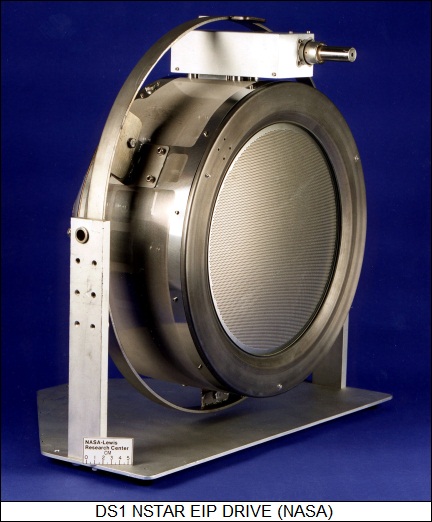
* The idea of using atomic power as the basis for a rocket engine predates the First World War, but at that time neither liquid rocket engines nor atomic power were realities, and these concepts were essentially speculations about speculations. However, by the end of World War II, both large liquid-fuel rocket engines and atomic reactors were working technology. In 1946, Douglas Aircraft performed the first formal study of the use of nuclear power for rocket propulsion, followed by a study performed in 1947 by Dr. Tsien Hsue-Shen (AKA Qian Xuesen), then at MIT. With enthusiasm for space exploration and nuclear power rising in the 1950s and into the 1960s, interest in using "nuclear thermal rockets (NTR)" reached a high pitch.
An NTR is very simple in concept. A light propellant, usually hydrogen, is pumped through a reactor core, which heats it to high temperatures, on the order of 2,500 degrees Celsius, and spews it out as a high-velocity exhaust. An NTR provides at least twice the specific impulse of LOX-RP propulsion. However, the improved mass ratio is partially canceled by the mass of the reactor, and particularly the mass of the reactor shielding.
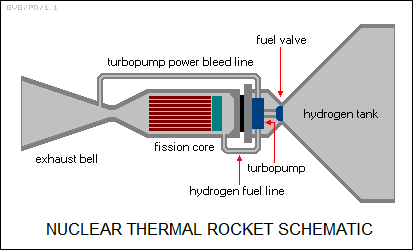
For this reason, many NTR spacecraft design concepts featured a crew compartment and propulsion system separated by a long truss to allow reduction in shielding mass, while still providing protection for the crew and spacecraft systems. A well-known design along such lines was the nuclear-powered "Discovery" Jupiter spacecraft used in Stanley Kubrick's meticulously detailed 1968 movie 2001: A SPACE ODYSSEY. Incidentally, the actual thrust generation system for the Discovery spacecraft was not defined, and the details more suggest a nuclear electric ion propulsion scheme, discussed in the next chapter, than an NTR.
* In reality, 2001 came and went, with nothing of the sort happening. The US Los Alamos National Laboratory, run by the US Atomic Energy Commission (AEC, now the Department of Energy / DOE) performed basic studies on NTR under the ROVER program, beginning in 1955, with NASA also beginning studies of its own in the late 1950s. The first ground test of an NTR, designated "Kiwi-A", was conducted in 1959 by Los Alamos. It was strictly a proof-of concept demonstrator, not intended for flight -- which is why it was named after the New Zealand kiwi, a flightless bird.
The Kiwi-A run was followed by "Kiwi-A Prime" and "Kiwi-A3" tests, featuring minor improvements, and then the "Kiwi-B" engine, which featured a developed fuel system. The last Kiwi tests were in 1964. They were followed by the "Phoebus" series of tests, which featured much more powerful engines. The first "Phoebus-1A" test was in June 1965, with "Phoebus-2" following in February 1967, and "Phoebus-2A" completing the tests in June 1968. Phoebus-2A produced an astounding 4 gigawatts of power. A scaled-down successor to Kiwi, the "Peewee", was also tested several times.
* Although these engines were ground test systems, in the meantime NASA formed a collaboration with the AEC to build a flight-worthy engine under the "Nuclear Engine for Rocket Vehicle Application (NERVA)" program. In May 1961, US President John F. Kennedy had called for high-priority development of NTR engines as an item in the famous Moon-landing speech, accelerating work on the project.
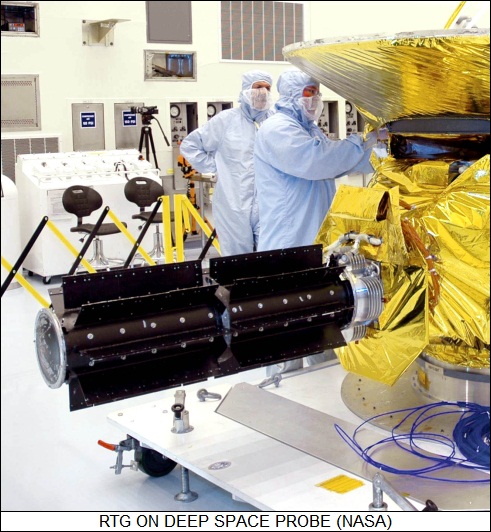
Within a few years, the NERVA program was focusing on an NTR that could be launched as an upper stage on the big Saturn V booster, then in development. The initial test run of the engine was in September 1964. More than 20 prototype NERVA engines were built and successfully ground-tested, with power levels between 40 and 4,000 megawatts, thrust levels up to 981 kN (100,000 kgp / 220,000 lbf), and the desired high exhaust velocities. Although the engineering problems were substantial, a flight test model of a NERVA engine was under development when the program was canceled in 1972, after the Nixon Administration cut NASA's plans for manned Mars exploration.
Of course, whatever the US did the USSR usually did. In the early 1960s the Soviet Union built a test facility named "Baikal-1" in Kazakhstan to develop an NTR, leading to initial tests of a prototype named "IRGIT" in 1978 and some further development work during the 1980s.
US work on NTR was revived in the late 1980s as part of the military "Timberwind" program, which envisioned a high-thrust "particle bed reactor (PBR)", where the reactor core consisted of a bed of spherical, jacketed fuel particles through which hydrogen could be injected, in contrast to the more traditional atomic pile considered in earlier NTR concepts. Timberwind was a secret program; information leaked about it in the early 1990s led to public controversy. In reality, Timberwind does not appear to have ever been much more than a paper project. As far as IRGIT went, the collapse of the Soviet Union in the early 1990s put serious work on NTR propulsion systems on ice.
* NTR still seems very attractive for a manned Mars mission, though worries about the environmental hazards of atomic power impose a heavy political and financial burden on any attempt to actually fly such an engine. NTR advocates believe that the safety concerns can be reasonably addressed, and NASA has recently worked on development of an NTR for deep-space exploration, leading to a lunar-flyby flight test in the 2020s.
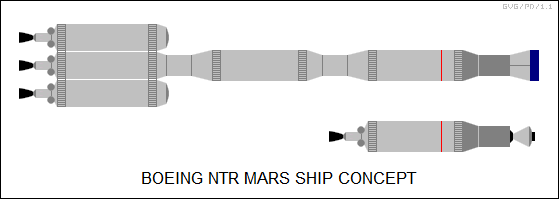
One NTR advocate, the well-known space engineer Robert Zubrin, has come up with some very original concepts for using NTR engines for a manned Mars mission. In principle, an NTR engine can use any convenient gas as a propellant. The only thing the gas provides is reaction mass, while the nuclear core provides the energy. Propellant gases could include those occurring naturally on other planets. If an NTR-powered spacecraft could refuel itself on Mars for its trip back to Earth, it would not have to be launched from Earth carrying propellant for the return journey.
The Martian atmosphere is 95% carbon dioxide (CO2). Theoretically, CO2 makes a poor NTR propellant, providing a relatively low specific impulse. However, Martian CO2 is free, and at ambient temperatures on Mars it can be liquefied by compressing it to six or seven Earth atmospheres. Subsurface water deposits could be used as propellant as well. A Mars lander with an NTR engine and a simple compressor system would be able to obtain its own propellant for hops over the planet, or a boost back into Mars orbit. Since CO2 or water would break down in the core and release reactive oxygen, the NTR fuel elements would have to be coated with a protective shell of non-corrosive material.
This scheme, based on "indigenous propellants" in Zubrin's term, would eliminate the need for a separate orbiting mother ship and lander, reducing overall mission cost. On return to Earth orbit, the spacecraft could be parked in Earth orbit, and be refueled and resupplied for further Mars missions.
Zubrin has also envisioned a space probe using a similar propulsion scheme that would explore Saturn's large moon Titan. Such a probe would be sent into orbit on a heavy-lift booster such as an Atlas V, and cruise to Saturn using its NTR engine and hydrogen propellant. The probe would be aerodynamic and would have pop-out wings. It would be able to periodically drop into Titan's atmosphere to explore and tank up its NTR engine with methane to allow it to explore the rest of the Saturn system, and even return to Earth with samples. The same approach could be used to explore Jupiter's moon Ganymede, or Neptune's moon Triton.
* Researchers at the Los Alamos National Laboratory have also considered another interesting NTR propulsion scheme, known as a "gas core nuclear rocket (GCNR)". In a GCNR, hydrogen is pumped into one end of a cylindrical reaction chamber, with an exhaust at the other end. The hydrogen expands as it passes through the chamber, and not all of it goes out the exhaust, instead flowing back up the chamber. This creates a toroidal vortex of hydrogen gas that can be used for fission reaction containment. Dust-sized particles of uranium are injected into the toroid and accumulate at its center.
A number of long cylinders are mounted on the interior of the reaction chamber outside the toroid. These cylinders normally absorb radiation emitted by the uranium, but they can be rotated to reflect it, initiating a fission reaction. The cylinders are the equivalent of control rods in an Earth-based reactor, and were apparently featured in earlier NTR designs. Once fission begins in the center of the hydrogen gas toroid, the high temperatures heat the gas into a plasma, which flies out the exhaust at high velocity to provide thrust. A small magnetic nozzle could be used to ensure that the uranium remains in the reaction chamber, while allowing the hydrogen plasma to escape.
GCNR was considered during the NERVA program, but the approach was clearly beyond the technology of the time. In 1991, Los Alamos sponsored a government-industry workshop on GCNR, and the participants concluded that the computer horsepower and software skills were finally available to perform useful studies and simulations on the approach.
The Los Alamos studies on GCNR were theoretical and speculative, and no program to actually develop one is planned. However, the studies have shown that a GCNR engine is much more efficient than a traditional NTR engine. A GCNR engine could be used to power a manned Mars mission that could reach Mars from Earth in 90 days, half the time required by a more conventional "solid core" NTR-powered vehicle. That would reduce mission cost and exposure of the crew to space radiation.
* More recently, in collaboration with NASA, the US Defense Research Projects Agency (DARPA) -- the Pentagon's "blue sky" development office -- has investigated an NTR under the "Demonstration Rocket for Agile Cislunar Operations (DRACO)" program, intended to support operations in Earth-Moon space. Contracts have been issued for DRACO systems, with a demonstrator to fly in 2025, but it remains to be seen if it will.
There has also been NASA-driven research on a "pulsed plasma rocket (PPR)" using a fission reactor. Descriptions are sketchy, but it appears that the PPR involves generating a plasma from some type of gas using a high-energy electromagnetic pulse, then accelerating the plasma with a linear electromagnetic drive system. It supposedly will be capable of both high thrust and high efficiency.
COMMENT ON ARTICLE* While the US and the Soviet Union were beginning work on NTR systems, a group of American researchers also considered a more direct and dramatic way to use nuclear power to propel a spaceship: detonate small atomic bombs behind it.
The ORION project, as it was named, seems to have originated with a secret report written by Stanislaus Ulam, one of the fathers of the US hydrogen bomb, after World War II. The idea was picked up or reinvented a decade later by Dr. Theodore B. Taylor, a well-known nuclear weapons designer. In 1957, Taylor was working at General Atomic, a branch of the General Dynamics conglomerate, in San Diego, California, when the Soviet Union launched Sputnik I, the first Earth satellite. General Atomic was promoting the peaceful uses of atomic power, and Taylor thought that America could catch up with the Soviets by building a really big spacecraft, a true "spaceship", powered by atomic bombs.
Taylor did some paper studies and came to the conclusion that the bombs would be small as such things went, with only a few kilotons of explosive yield. Even at that size, they would be about a million times more powerful than a chemical rocket. Taylor's initial studies led to the establishment of PROJECT ORION in mid-1958. Dr. Freeman J. Dyson, now famous both for his work in theoretical physics and for his brilliant speculative books, was then at the Institute for Advanced Studies at Princeton, New Jersey. He was contacted by Frederick de Hoffman, who had founded General Atomics, and told about the ORION concept. Dyson so intrigued that he took a leave of absence to go west and work on the ORION. Ultimately 19 people worked on the project, which was kept a deep black secret.
As Taylor explained it: "The general idea was that if you explode a bomb with roughly the yield of the one that destroyed Hiroshima or Nagasaki, then anything within a few hundred feet of that would be vaporized instantly. And that was not true."
The ORION team visualized their spaceship as something like a giant inverted pot or metal beehive, with a heavy "pusher plate" connected to the bottom of the ship through huge shock absorbers. A "gun" ran down the center of the ship, ejecting a sequence of small nuclear bombs through a hole in the plate. The bombs were detonated a few hundred meters behind the spacecraft. They were wrapped in a cold, inert material that would produce a plasma shock wave to boost the ship through space. The ship was seen as about 30 meters tall and 30 meters in diameter at the base. The pusher plate covered the bottom and was envisioned as about 30 centimeters thick.
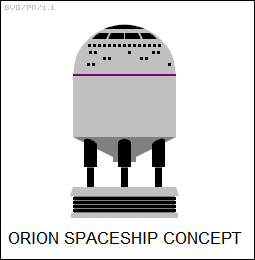
The group began to conduct small-scale experiments at the Point Loma Navy Base outside San Diego, with funding provided by the Pentagon's new Advanced Research Projects Agency (ARPA). The researchers focused on the construction of 1:30 scale models driven by plastic explosives. The models were known as "Put-Puts" or "Hot Rods". The initial experiments were intended to determine if a pusher plate could actually stand up to a sequence of explosions. The tests showed that the pusher plate tended to bend inward at the middle, and so it was redesigned to be thick at the center and taper outward towards its edge.
The next problem was "ablation" of the pusher plate, the boiling away of the surface of the plate with each atomic blast. This required appropriate selection of a plate material. A number of candidates were considered, with some sort of fiberglass heading the list. Spacing of the bomb detonation behind the ship was also important. Too close, and the ship would be destroyed; too far away, and the energy of the blast would be wasted.
Another problem was the protection of the crew from the radiation of the blast. Surprisingly, fiberglass turned out to work fairly well as a radiation shield. The ORION design also had a special compartment that was heavily shielded where the crew would go during the intermittent "boost phases" of the ship.
The ship was to be launched from a barge far out in the ocean to reduce the effects of the blasts on the environment. Unfortunately, ORION would leave a trail of radioactive debris or "fallout" as it climbed into the sky. It was possible to design the bombs to be relatively "clean" to minimize the fallout, and they were small to begin with, but it was not possible to eliminate the fallout completely.
The bombs were actually known as "nuclear pulse units (NPU)", and they resembled big hockey pucks. ORION would carry several thousand of them. They were stacked around the breech of the gun in the middle of the spaceship so they could be automatically loaded, ejected, and detonated.
Another problem was the shock of the explosions, since the gee forces of the blasts could destroy the ship or crush the crew. Some of the subscale models were simply blown apart in tests, and the group tried to insert shock absorbers between the pusher plate and the ship. One shock absorber design consisted of a stack of inner tubes, wrapped with duct tape for reinforcement. Developing a reliable shock absorber system proved troublesome. A particular problem in terms of shock protection was the stack of nuclear pulse units carried by the ship, since the gee forces could easily wreck their precision fuzing circuitry, turning them into duds. The bombs were to be mechanically "hardened" and fitted with their own shock absorbers to protect them.
* On 12 November 1959, the group successfully launched a Hot Rod flight-test prototype that reached an altitude of 30 meters and parachuted successfully back down to the ground. Films of the Hot Rod blasting up into the sky on successive explosions remain an astonishing testimonial to the ingenuity of the ORION team. Even some members of the team were surprised that the thing flew.
The ORION team had big ambitions. They felt that a full-scale ORION spaceship would be able to tour the Solar System, for example reaching Jupiter after a year's flight time. The ship wouldn't be a cramped space capsule, either. Although 30 meters doesn't sound very tall for a rocket, unlike a chemical rocket, which is mostly fuel tanks, ORION would be mostly payload. The ORION team envisioned their spacecraft as having a cafeteria, an observation deck, a small hydroponics greenhouse, even a barber shop. When in May 1961, US President John F. Kennedy announced that America would put a man on the Moon by the end of the decade, the ORION workers smiled, thinking they could be headed for Saturn by then.
However, the visionary nature of the project and its secret status worked against it. ARPA funding had dried up in late 1959. The ORION group managed to get more money from the US Air Force, though the military was skeptical of the idea and only provided funding for feasibility studies, not for further Hot Rod flights. The ORION group approached NASA as well. Ted Taylor briefed Wernher von Braun of NASA and other NASA officials about ORION to see if he could get support from the agency. Von Braun dozed through the briefing until Taylor showed the spectacular HotRod launch film. Von Braun went immediately alert and showered Taylor with questions.
Von Braun became a believer, but though NASA funded further studies on ORION, it wasn't enough to save the project. The agency was simply not comfortable with the idea -- it was too different, too risky. Ultimately, the unsolved problem of radioactive fallout killed ORION for good. Any ORION launch would have led to public protests, and the Atmospheric Test-Ban Treaty, signed in August 1963, basically made an ORION launch illegal. ORION was finally canned for good in December 1965. It remains an interesting footnote to a time when people were crazy about space, crazy about the atom, and thought they could accomplish anything.
BACK_TO_TOP* ORION proved to be a dead end, but NTR remains attractive. It is basically a simple idea, involving no more than heating up a gas to use for an exhaust jet. The biggest drawback is that the means that it uses to heat up the gas, nuclear power, is unfashionable these days. NASA has considered an alternative approach that is much trendier, in which solar power is used to heat up a propellant instead of a nuclear reactor. The idea is not new, having been proposed by German-American spaceflight engineer Krafft Ehricke in 1956, but little was done on the concept until recently.
In 1997, NASA launched a study of such a "solar thermal rocket (STR)" engine named "Shooting Star". Shooting Star was envisioned strictly as a test system, using a Fresnel lens 1.8 meters in diameter supported by an inflatable structure to focus sunlight into the rocket engine, which would then generate about 250 grams of thrust by heating hydrogen to 1,650 degrees Celsius.
An operational STR engine would have one or two mirrors, supported by an inflatable structure made of a foam that hardens on exposure to ultraviolet. The large concentrators would focus sunlight on the exhaust chamber to produce temperatures of 2,750 degrees Celsius, producing thrust with a specific impulse about three times that of LOX-RP propulsion. The engine could be used to transfer payloads from low Earth orbit to geostationary orbit, or to power an unmanned lunar shuttle.
The idea is very elegant, though it seems unlikely that it could be scaled up to any great size. It would also not be very useful for exploring the outer Solar System, where the intensity of sunlight is low, although a high-powered laser station could be used as an alternative source of energy for such missions. The Shooting Star study was supposed to have produced the test system for launch as a space shuttle secondary payload, but it then disappeared.
In the spring of 1998, the US Air Force awarded a contract to Boeing to perform initial studies for an orbital transfer vehicle, or "space tug", powered by an STR engine, with the designation "Solar Orbital Transfer Vehicle (SOTV)". The contract followed Boeing tests of an Earth-based static-test STR demonstration system in 1997. Boeing's concepts for the SOTV envisioned a spacecraft built around a liquid hydrogen tank, with a spacecraft bus at one end and an STR engine at the other. A mirror was directed by a sunlight-tracking system to focus light onto a graphite "receiver-absorber-converter (RAC)" block, which contained channels for heating the hydrogen, as well as four thermionic converters to provide electricity for spacecraft systems. The thermionic converters used radiators mounted on the spacecraft to dissipate heat.
Fully fueled, the SOTV was 3.35 meters long and 1.22 meters in diameter, a size that allowed it to be launched by a light launch vehicle, and weighed no more than 620 kilograms. The concept went on the shelf for decades, but has now been revived by a startup company named Portal Space Systems, which is working on an SOTV named "Supernova", using military funding. Portal doesn't appear to have any direct connection with Boeing.
BACK_TO_TOP